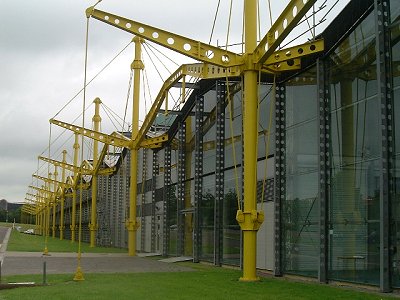| Sorted by date | |||
page015from Building IdeasTwentieth Century Architecture – The Dominanceof the Machine The First layer consists of the buildingthat set the pattern for the current love affair between the world’s commercialand civic institutions and the idea of the building as a machine – the PompidouCentre in Paris, completed in 1977. Designed by Richard Rogers and Renzo Pianotogether with the engineer Ted Happold, the building responded to the demandsof the competition brief for what we now refer to as a “mediatheque”,containing art galleries, temporary exhibitions, library, café and a research centre formusic and acoustics. The competition drawings show not a building so much as ahuge steel grid structure hung with escalators and giant cinema-screens facinga plaza- here ... more ...
|
|||
|
|||
|
|
|||
page014from Building Ideas2 Foster and Partners – Renault DistributionCentre, Swindon, 1980-82. (Alistair Gardner)
 ... more ... ... more ...
|
|||
|
|||
|
|
|||
page013from Building IdeasSince the Lloyds buildings was finished, Roger has gone on to complete a number of substantial projects in a similar idiom, from the spiky steel and glass headquarters of Channel 4 London(1994) to the more curvaceous forms of the Strasbourg European Court of Human Rights and the Bordeaux Law Courts (1995 and 1998). He is now engaged on a new office building for the German car giants Daimler-Benz, in the centre of Berlin. Roger’s former partner (and fellow recipient of a knighthood for his contribution to British architecture) Norman Foster, has likewise assembled an impressive portfolio of significant international commissions – not least of which, the Hong Kong and Shanghai Bank headquarters – was completed in the same year as Lloyds and embodies a similar range of architectural preoccupa... more ...
|
|||
|
|||
|
|
|||
|
|||
|
|
|||
page011from Building IdeasArchitecture as Engineering
The Technological Revolution
When the new headquarters building for Lloyds of London was completed in 1986 the public reaction was understandably confused. Instead of the traditional image for a city institution of a classical temple standing for permanence and solidity, the insurers – not a profession famed for taking unnecessary risks – had chosen to erect themselves a gigantic piece of pulsating machinery. The associations were clear for all to see: the exposed structure like an oil rig with its spars and platforms, the shiny metal stairs and toilet-pods all piled up like freight containers and clipped on to the outside, and the whole thing capped off with a small army of rooftop cranes – not there just to help build it but there to help rebuild... more ...
|
|||
|
|||
|
|
 ... ...
... ... ... ...
... ... ... ...
... ... ... ...
... ... ... ...
... ... ... ...
... ... ... ...
... ... ... ...
... ... ... ...
... ... ... ...
... ... ... ...
... ... ... ...
... ... ... ...
... ... ... ...
... ... ... ...
... ...